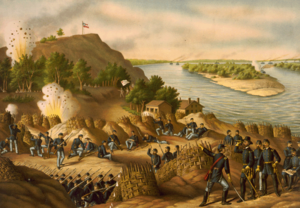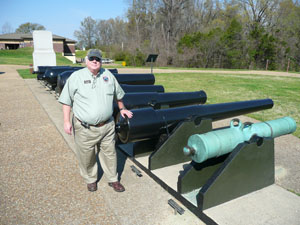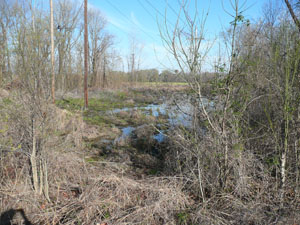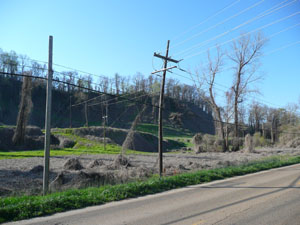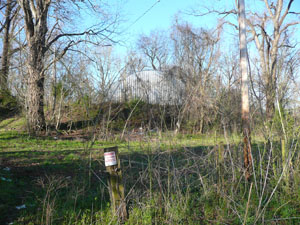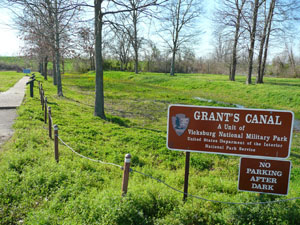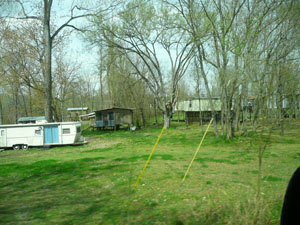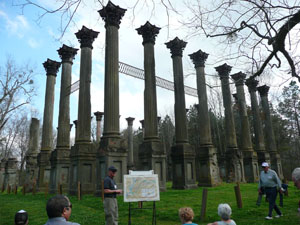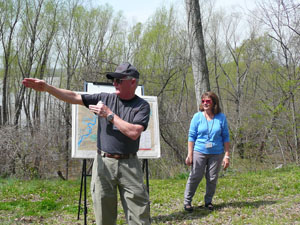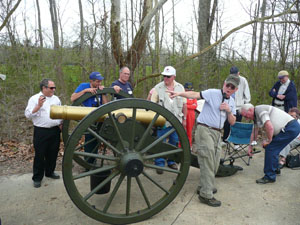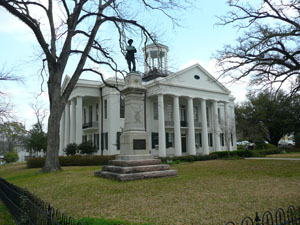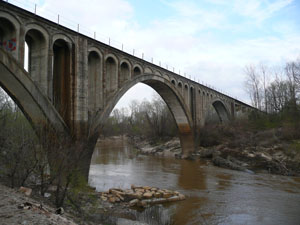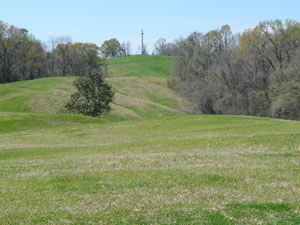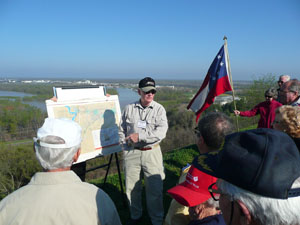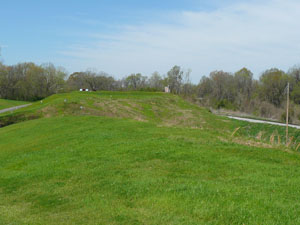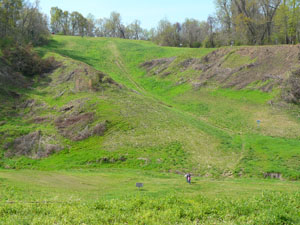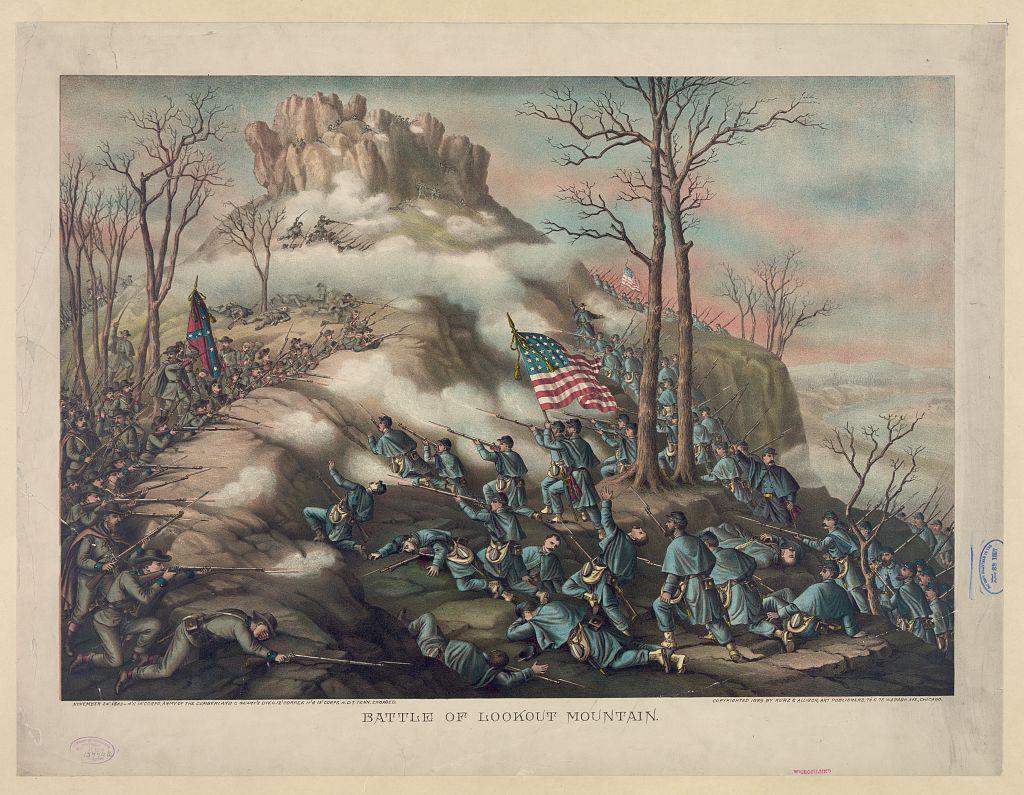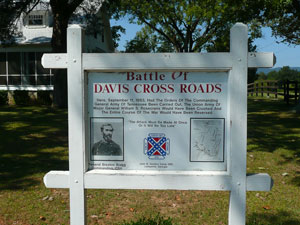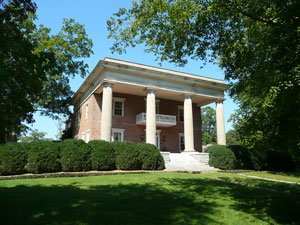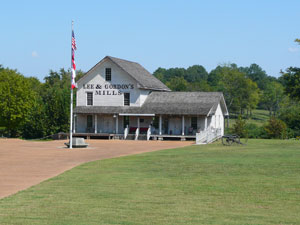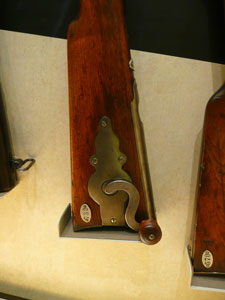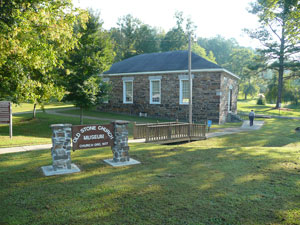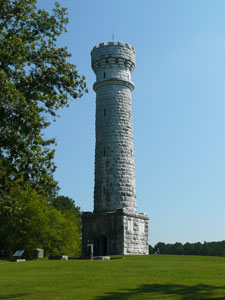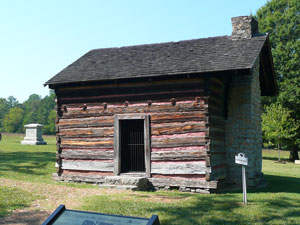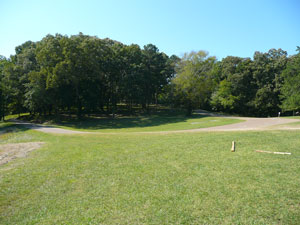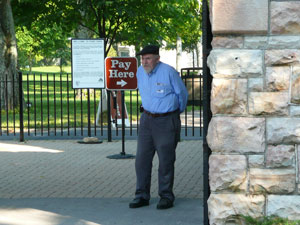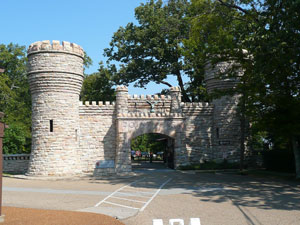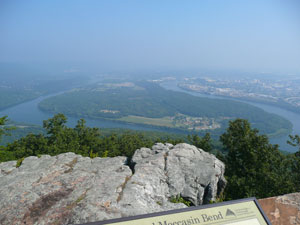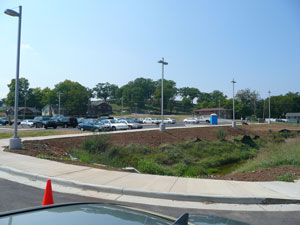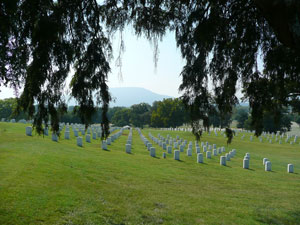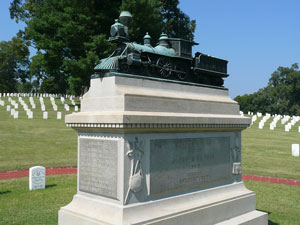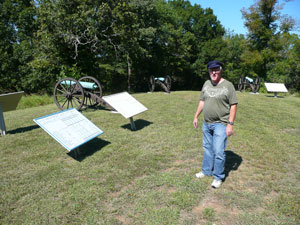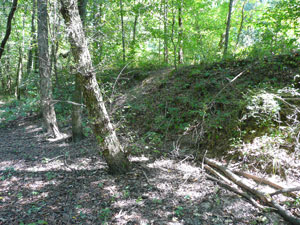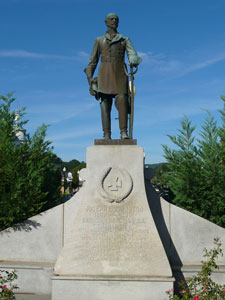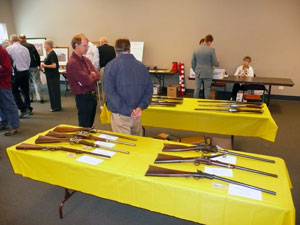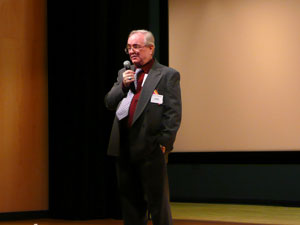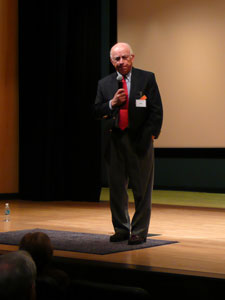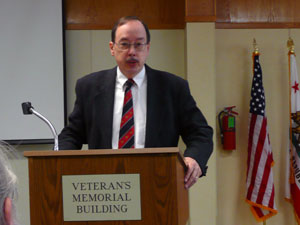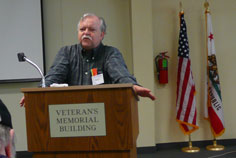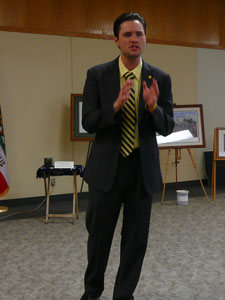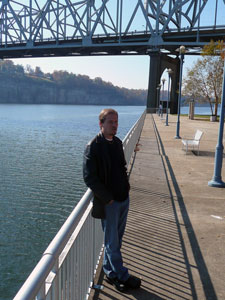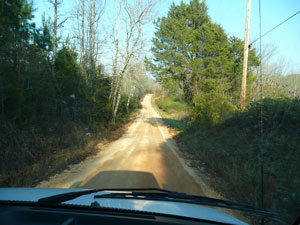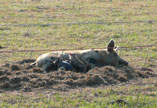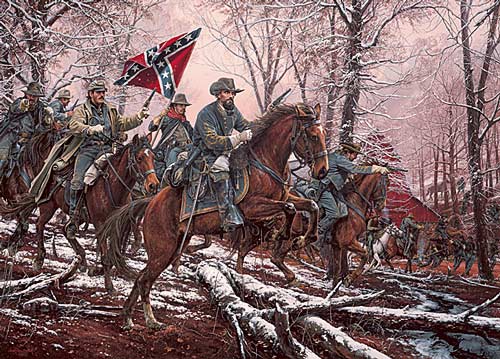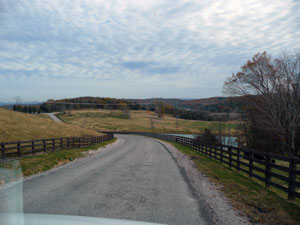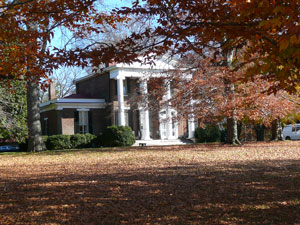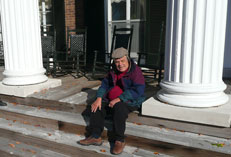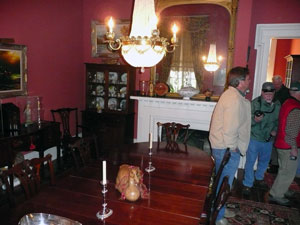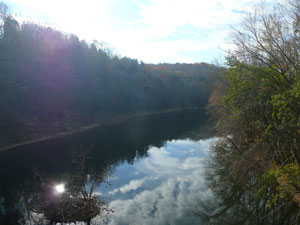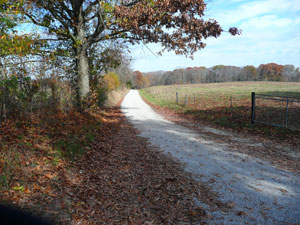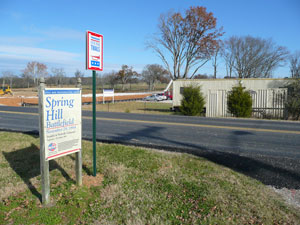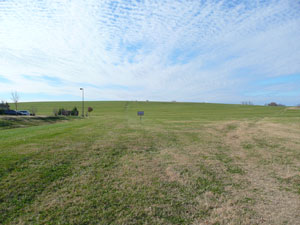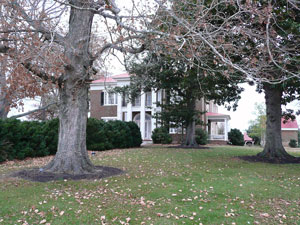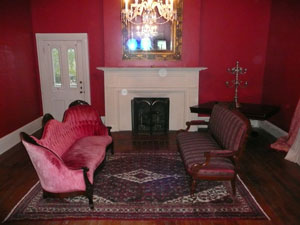2008 Civil War Travelogue
Welcome to my 2008 travelogue page. A fun year with four trips:
- Vicksburg, March 15-21
- Trip to Northern Georgia to visit Chattanooga, Chickamauga, and Kennesaw — September 21-26
- West Coast Civil War Round Table Conference, Clovis, CA — November 7-9
- BGES Staff Ride of Spring Hill, TN — November 19-22
| Here is a reminder about the reason I write these pages the way I do. They record my experiences and impressions of Civil War trips primarily for my future use. Thus, they sometimes make assumptions about things I already know and focus on insights that I receive. They are not general-purpose descriptions for people unfamiliar with the Civil War, although I do link to various Wikipedia articles throughout. Apologies about the quality of interior photographs—I don't take fancy cameras with big flashes to these events. If you would like to be notified of new travelogues, connect to me via Facebook. |
I have changed my HTMLing this year; now, if you click on a small photo, you'll get the full-size version in a separate window.
Vicksburg, March 15-21
|
Here is a report on my first Civil War trip of the year. I have been with Parker Hills on two Blue and Gray Education Society staff rides, so I accepted his recommendation that a Vicksburg Campaign tour that he gives through the Elderhostel organization would be a good fit for my needs. (I was initially concerned that it might be too rudimentary a study, but he assured me that many of the attendees are history buffs and he does not dumb down the curriculum.) I have actually been to Vicksburg twice in my life before this—once as an ROTC cadet and then again in 1976 on my honeymoon, if you can believe that!
As I usually try to do, I spent some time before the tour upgrading the relevant Wikipedia articles with more complete text and a better set of maps:
Saturday, March 15
I flew to Jackson, Mississippi, about 50 miles east of Vicksburg, and rented a car. The group headquarters is the Battlefield Inn, just a few hundred yards from the entrance to the Vicksburg National Military Park, and it is modest, but comfortable. (Lots of free stuff, though: free breakfast, free WiFi, free cocktails.) I wandered around the downtown area overlooking the Yazoo Canal—the Mississippi River relocated itself away from Vicksburg in 1876. I had dinner at an old restaurant called Borrello's, which was a steak and Italian food place, with pretty good food. Some locals I talked to said that it was expensive, but they have never been to San Francisco. :-) The downtown is very quiet and rather careworn. Tony Horwitz, in Confederates in the Attic, described it as "picturesquely seedy, a sort of downmarket Natchez with cannons and kudzu." The biggest change I noticed since 1976 was that four large casinos have been installed on the River.
Sunday
I got to Vicksburg a day earlier than necessary because I wanted to make sure that I was not delayed for the start of the program, so I had most of the day on my own. I hired a licensed battlefield guide named Gary Webster to show me some things that I knew Parker would not be covering later in the week. This licensed guide program is a good deal more informal than the one at Gettysburg, but Gary seemed to know his stuff. We started out by driving north to visit Chickasaw Bayou, which William T. Sherman unsuccessfully assaulted on December 29, 1862, the opening battle of the long Vicksburg campaign. This battlefield is not really preserved in any way and is mostly covered in decrepit houses and trailers, but you do get an idea of the terrain. It seemed a lot drier to me that I was expecting. The bayou was practically only a puddle, whereas in Sherman's day it was a major obstacle. (The hydrology the area is rather different now in general.) We took a look at the Indian Mound, the site of one of the major attacks, and I was surprised to hear that it had no religious significance, but was merely a high point that the Indians used to escape seasonal river flooding. It's currently behind a chain link fence and has a Quonset hut built on top of it. We also drove past the three major bluffs in the area, Chickasaw, Drumgould's, Snyder's, and Haynes. These were all pretty impressive obstacles, although the Confederates had their infantry battle lines at the bases, where the current highway runs.
|
|
Driving back through town, we visited some of the monuments that are no longer within the National Park Service boundaries, Louisiana Circle (site of the Widow Blakely cannon), and South Fort, the southernmost fortification below Vicksburg. We crossed the Mississippi River and visited Grant's Canal, which is now just a shallow depression no more than 4 feet deep and about 150 yards long. It was nice to visit for the historical vibes, but there really is not much to see here, folks. Move along.
|
In the afternoon I decided to scope out the military park's road network in case I felt like running. I found that it was too hilly for running on a vacation, so after driving most of it I dismounted and walked about 6 miles of the 16. The weather was simply superb today, sunny and about 70° with reasonable humidity. I am going to forego comments about specific locations on the battlefield until I revisit them with Parker later in the week, but I will say that this is a very beautiful battlefield with very impressive terrain. It is unfortunate that it is primarily forested today, whereas in 1863 it was like a moonscape. It has more monuments than any place I have seen other than Gettysburg, and some of them are superior. It seems as if every colonel and general, particularly in the Union Army, has either a large bust on a pedestal or a bas-relief portrait on a monument. I took a lot of snapshots with my tiny camera, but this would be a place for a good photographer to spend a few days with a tripod and do a catalog of all of these portraits.
The Elderhostel group met for a social hour and I found that they were not hostile at all! :-) It was good to see Parker again and meet his wife and "chief of staff," Carol. We had a group dinner in the hotel and then spent an hour or so introducing ourselves to the group of 50 attendees.
Monday
We started with a 2.5-hour PowerPoint presentation and lecture by Parker Hills, entitled "Winter of Discontent," which covered the background of the Vicksburg campaign and all of the early efforts from November 1862 up to getting Grant across the Mississippi River at the end of April 1863. It was very interesting and comprehensive, although I cannot say that I enjoy the heavy use of PowerPoint animation and sound effects as much as some of the other attendees seemed to. (Parker set a new record in my book. This particular PowerPoint presentation was 160 MB and I have never seen one even 1/8th that large. And my negativity is only tongue-in-cheek because his presentations were obviously enormous amounts of work and they masterfully wove together all sorts of historical images, maps, and current photographs to give very clear explantions of complex campaign and tactical issues. This would become particularly apparent on Wednesday, showing assaults around Vicksburg.)
Since I had done a lot of research on the campaign, there were few surprises for me, although I did not know that Grant wore false teeth and that his orderly managed to throw them into the river by mistake in February. We finished up with a lunch catered from the Wal-Mart fried chicken department. It is an odd hotel does not have lunch service, although I suspect Sam Walton's fried chicken is better than the Battlefield Inn's. But then on to the bus...
We drove south from Vicksburg to the Grand Gulf Military Park and I got another surprise. Every time I've seen Grand Gulf on a map, I assumed it was like a mini Fortress Vicksburg, a mighty town on a hill dominating the river. When we got there, it was essentially a few shacks and trailers ("manufactured homes"), most of which were elevated 10 feet or more on stilts. It turns out that the town had about a thousand people in earlier in the 19th century, but a series of natural disasters wiped most of it out and the Civil War population was 158. That was before Admiral Porter burned the town. We visited the two forts (Cobun and Wade) where the artillery guarded the river and also a small eclectic museum that was connected to a camping ground. When I say eclectic I mean that it had everything from Civil War bayonets to Model T spark plugs.
|
|
The next step should have logically been Bruinsburg, where Grant's men landed on the eastern shore of the Mississippi, but we could not get the bus close enough, so we stopped nearby at the ruins of the Windsor plantation, which featured an enormous mansion that had burned in 1890, leaving only a series of gigantic columns evenly spaced, somewhat reminiscent of the temple at Luxor, Eqypt. The house would have been really spectacular had it survived. The final stop of the day was to Bethel Church for a discussion of the battle of Port Gibson; once again, the bus was not able to accommodate getting to the exact spot we needed, but we got a very good overview. There was an amusing 60s-era wayside sign at the church that say PG was "one of the turning points of the War between the States"! Parker told us that PG's slogan, "A town too beautiful to burn—U.S. Grant," was made up by a local businessman in that same time frame. But Earl Van Dorn is buried there, so the town does have something tangible to cling to.
During the field trips, Parker made very good use of an easel with large campaign maps, on which he used erasable markers to show troop movements and actions. It was disappointing that his wife Carol, holding up the easel against the wind, wasn't able to provide the little sound effects like the PowerPoint presentation. (Kapow! The gunboat was sunk, gurgle, gurgle, gurgle.) :-)
|
|
Back at the hotel, we had our social hour and dinner, followed by another hour of presentation, "March to Destiny," in which we received an overview of the battles of Raymond, Jackson, Champion Hill, and Big Black River Bridge, setting us up for our full day bus tour tomorrow.
Tuesday
Today was entirely on the bus, covering the battles prior to the Siege. We drove to the Natchez Trace, the ancient trail that goes 440 miles from Tennessee through Mississippi. There wasn't much of a connection to the Civil War, but what the heck. It's history. From the Trace Parkway, we found our way to Grindstone Ford, the place the Union first crossed the Big Bayou Pierre, which caused Grand Gulf to be evacuated by the Confederates. As is usual on this trip, the hydrology of the region has changed and the site of the ford is no longer actually touching water, so there was not much to see, but Parker gave a detailed briefing on the early part of the campaign after the battle of Port Gibson.
|
|
Back on the bus to Raymond, where we visited the local Subway shop and 50 people got to stand in line waiting for custom-made sandwiches. Apparently Raymond is not the tourist dining Mecca that I would have assumed. Then we drove out to the battlefield, which is essentially two giant cornfields, flat as pancakes, with a few replica cannons. Parker gave us a detailed description of the battle and went into a lot of history of the preservation efforts for the battlefield. When they are completed, this may be the only battlefield that has a one to one ratio of cannons to the actual battle. We had a fun exercise of running through an artillery crew drill with four volunteers. Back to the town of Raymond again, we visited a tiny Episcopal Church (which was right next to restrooms) and then the county courthouse. Parker is friends with the judge and, since court was not in session today, we went into the courtroom to check out recent historical renovations that the Friends of Raymond have financed. We also went into the jury room, where the jury deliberation table was used for amputations after the battle.
|
The next major battle was Champion Hill and I was a bit disappointed that I did not get to see more of the terrain. We stood on the southern outskirts of the battle and went through another detailed explanation. I am hopeful that I can visit other parts of that battlefield on my way to the airport on Friday. We finished up the day at the Big Black River Bridge. The original Civil War bridge and its replacement are long gone, of course, but we got an idea of what was there by looking at the current railroad bridge. Parts of the original Civil War bridge's foundations are still there, just recently emerged from the winter high water.
After dinner we were serenaded by two guys who perform in period uniforms under the name "Hard Tack and Coffee." They were quite talented and sang a number of Civil War era songs, both those familiar and new to us. the crowd favorite was "Goober Peas," which I had never heard before.
Wednesday
Back to the classroom today for a presentation on the two assaults (May 19 and 22) and the siege of Vicksburg (May 25 to July 4). An interesting tidbit I didn't know was that the Union soldiers practiced an early type of biological warfare on the Confederates, by fouling all their water supplies with human waste and dead horses. John S. Bowen, one of five generals to die in the campaign, fell to dysentery just after the siege. I also thought Parker's insight on the effects of Isaac Quinby's division not advancing on May 22 was very interesting; he pretty flatly claimed that McClernand's assault would have retained the Railroad Redoubt if Quinby had been next to him as planned. I knew Quinby's grandson while I was a kid in New Jersey, although that was long before I had any interest in the War.
We interrupted at lunchtime for a 3.5-hour block of free time. I planned to go back and walk some more of the battlefield, but it started to rain just as I stepped outside. Phooey. I can take rain as part of a group program, but walking out there alone in it is just too much stoicism for me. We concluded the presentation on the siege late in the afternoon. After dinner, Parker presented ''Guns on Western Waters'', about the history of the early brown-water navy.
Thursday
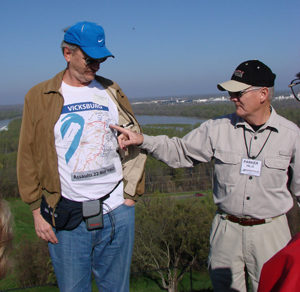 |
Parker explains the Assault on the Left Nipple |
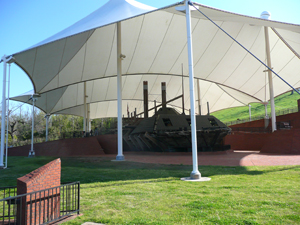 |
USS Cairo |
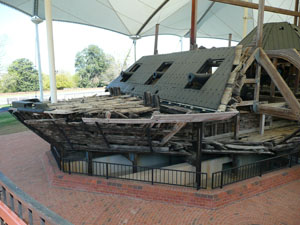 |
Detail of bow |
The weather is beautiful again! Another day on the bus, but this one pretty local, focused mostly on the Vicksburg National Military Park. We drove north and stopped at the place that Grant and Sherman met up on May 18 to see that the Army had finally reached the Union supply ships at Chickasaw Bayou, and where Sherman finally acknowledged that Grant seemed to know what he was doing in the campaign. I wore my newly designed Vicksburg T-shirt and Parker called me up to the front of the group to show some of his points on the map on the front of my shirt. (You can purchase your own copy of the shirt by going to zazzle.com.) Then we visited the USS Cairo, which had been sunk by a torpedo (what they call naval mines at the time) in December 1862 and had been famously discovered and raised by Ed Bearss. It's now on display underneath a giant tentlike structure. They have done some artful filling in the blanks to cover a lot of missing and damaged pieces of wood and armor, but the pilot house is there, as are all the guns and the engines. Very impressive. There is also a tiny museum that contains hundreds of artifacts that they dredged up with the boat, such as tools, dining room implements, personal effects, etc.
We took a detour to downtown Vicksburg and had lunch at the Anchuca Mansion, which is a beautiful antebellum home that is now a B&B. This stop was really the ladies' revenge—in exchange for a week of battlefield glory, death, and destruction, we men had to sit through a lunch of quiche and visit numerous rooms full of antiques. I will have to say that my impression of downtown Vicksburg was raised a notch because we passed through some nicer areas with more beautiful homes than I had seen on any of the previous days.
Back to the battlefield, we followed the automobile tour route from a nontraditional starting point, which meant that we explored the Confederate fortifications first. Our first stop was at the Stockade Redan area, where we got a detailed look at Sherman's assaults around the Graveyard Road on May 19 and May 22. One of the ladies on the tour had a direct ancestor who was killed as the 4th West Virginia attempted to storm up the very impressive hill on the 19th. (Once those poor soldiers ascended these natural obstacles, they had to face a large, deep ditch filled with man-made obstacles and then a very tall earthen wall before they could reach the Confederates. All of the assaults in this sector failed.) So there was a sense of personal poignancy about this spot. And also a sense of annoyance at how poorly Sherman did in this part of the battle.
On a lighter note, we visited the Iowa Memorial and Parker, who was an art major in college, gave us a detailed review of the beautiful bronze sculptures by Henry Hudson Kitson, each of which told a story about a different phase of the campaign. We spent some time in the visitor center and bookstore, which has a very nice collection. I bought a small book that Parker wrote about the Battle of Brice's Crossroads and he autographed it for me. We drove by Logan's Approach, which was a simply stupendous steep hill that the Union painstakingly dug trenches to approach and lay explosives under. Throughout the week, Parker had been telling us about all of the poor soldiers and Marines he tormented by challenging them to run up hills that the Union soldiers had run, and this one was certainly the worst. (I was thankful that Ed Bearss was not giving the tour because I'm sure he would have had some of us running up that hill behind him.)
We drove by the 3rd Louisiana Redan, where the explosives planted by the approaching the Union men had actually been exploded, producing an experience somewhat similar to the Battle of the Crater in Petersburg, 1864. (It is amazing to me that Grant did not learn a lesson from this failed experiment and that so few historians mention it.) Then to the Illinois Memorial, an imposing marble structure that is a one-quarter sized replica of the Pantheon in Rome. We finished up the afternoon by visiting Grant's headquarters area and had a discussion of the controversies surrounding Grant's drinking and the congratulatory letter he received from Abraham Lincoln after the successful campaign. I think my only disappointment of the week was that we did not have more time to spend on the battlefield itself. There were three or four stops that I would have liked to have made, but caught only fleeting glimpses from the bus window. I'm glad that I was able to spend a few hours on my own Sunday.
|
|
|
|
After dinner, we had an experience unique in my Civil War travels. Parker had been warning all week that a quiz was coming Thursday night, but it turned out to be a quiz show, "Yanks vs. Rebs." He and Carol put on a convincing simulation of the old Regis Philbin Who Wants to Be a Millionaire TV quiz, complete with the correct music and even flashing lights at the appropriate points. I happened to be the first contestant and was able to win 50 Confederate dollars (the maximum), which I exchanged for a 1.25-pound chocolate fish! Most of the questions were pretty easy, but the $50 question was harder than any of the other ones I heard during the evening—the name of the Union colonel killed in the Battle of the Big Black River Bridge. It's lucky I didn't look like a dope. I passed the chocolate fish around the room, by the way, not needing any more calories. It is surprising to me that these Elderhostel attendees are able to keep their weight down after all this food.
Friday
We wrapped up the week with a 1.5-hour PowerPoint session on how well Grant followed Clausewitz's principles. (Just as interesting, but unstated, was how poorly Pemberton did it.) I returned to the battlefield to explore things I'd missed before, such as the Railroad Redoubt, Square Fort, and the 2nd Texas Lunette. I actually did the full 16-mile loop so that I could photograph more of the busts and portraits of the generals. Then I hit the road and headed for the airport by way of Champion Hill; when we covered that battle on Tuesday, we only saw the southern edge of the field. I found that the Hill is a rather modest ridge—no Round Top here—but that sort of feature can turn out to be a very good defensive position. I also found that when you do your own driving, the area is REALLY rural, with poorly marked roads and places you just wouldn't want to be lost in for long.
So a long week comes to an end. I had a great time on my first Elderhostel and will probably investigate more on other topics—maybe even ones Nancy would be interested to attend! Parker and Carol did a great job and I met a lot of really nice people. I understand that this Elderhostel had a waiting list and they've planned two more in the fall to accommodate the heavy interest. I'd recommend it to any of you old codgers (55+) out there.
Chickamauga and Chattanooga, September 2008
I hit the Civil War trail again with a novel twist—I was able to find a venue that also interested my wife Nancy so that we had our first joint vacation involving the Civil War. The Elderhostel organization, with whom I visited Vicksburg earlier this year, offered a program in Crandall, Georgia, called "Just Horses Extreme." Nancy has been interested in horses since she was a girl and this program offered extensive classes and trail riding experiences for her and a lot of free time for me to visit nearby battlefields. The program was located in the Cohutta Springs Conference Center, a beautiful set of lodges and campgrounds in northwest Georgia, almost at the Tennessee line, about 50 highway miles from Chattanooga. We had dinner together each night, but that was about the extent of the horses for me. (This webpage is not about her program, but I can say that she had a fabulous time and learned a lot. The staff was great and all of the small number of participants in the program were very friendly. Nancy also exercised muscles she has not remembered for decades. We will probably be on the lookout for other horse oriented Elderhostel programs in the future.)
|
I was able to arrange the services of two expert tour guides to shepherd me through the terrain: Raymond Evans, an archaeologist, author, and Civil War historian who specializes in the Chickamauga Campaign (as well as Native American and Spanish colonial interests), and Chuck Hamilton, a colleague of mine on Wikipedia who has lived near Chattanooga for his entire life and is a Civil War buff and occasional reenactor. So this was an intense experience with me driving and interacting full-time, rather than the more common bus riding and listening to lectures experience. My thanks go out to both Ray and Chuck for a great week full of inside info and insights. (For those interested in this, Ray has developed a business leading individuals and tour groups around Chickamauga and Chattanooga when he isn't writing or promoting the campaign. I would be happy to provide introductions.)
One note before I start: I often write the Wikipedia articles about the battles I am visiting before I set foot on the locale, but in this case I could not arrange the time to do all the research, so the articles Battle of Chickamauga and Battle of Chattanooga were in a rather mediocre state when I wrote the travelogue. I have since updated Chickamauga and will work on Chattanooga soon.
Monday, September 22
I picked up Ray at his house in northern Chattanooga and we started by driving to a position overlooking the city from across the Tennessee River to the north. It was here that the Union artillery bombarded the city in what Wikipedia calls the Second Battle of Chattanooga. Col. John T. Wilder led a diversionary raid to convince the Confederates that Maj. Gen. William S. Rosecrans was going to be moving around Chattanooga to the North and his artillery chief, Capt. Eli Lilly (who later founded the giant pharmaceutical company), kept the Rebels occupied dodging expertly aimed shells. Wilder is undoubtedly the most interesting character of my trip. I recently wrote the Wikipedia article on the Tullahoma Campaign and he was the star, commanding a mounted infantry brigade whose soldiers obtained their horses by appropriating them from the countryside and buying their own Spencer repeating rifles. What I did not understand is that after the Union secured Chattanooga and Gen. Sherman moved on to the Atlanta campaign, Wilder stayed behind in Chattanooga as quartermaster and he and some of his colleagues essentially took over the city. They ran out any Confederate sympathizers and took advantage of Army procurement contracts to set up their own successful enterprises. Wilder himself was the mayor of the city for a number of years and became a wealthy man, very influential in the preservation of the Chickamauga battlefield.
The theme for my first day of traveling was to follow the activities of the XIV Army Corps under Maj. Gen. George H. Thomas. Ray particularly likes to find out in advance on whom a client wants to focus—a person or unit. I told him John Wilder, George Thomas, and James Longstreet were of particular interest to me during the campaign. So we took a long drive to visit the camp on Battle Creek where Thomas's units came down from the Cumberland Plateau. We explored the area around Trenton and I was particularly interested to see that along the way, around Marion County, TN, an area completely dominated by the fireworks industry. Giant billboards for fireworks stores are everywhere, defacing an otherwise beautiful landscape. (The Chattanooga area is visually just stunning with very dramatic mountains and valleys throughout the urban area.) We followed the route of the troops through Stevens Gap and into the valley called McLemore's Cove. (It was not really a valley, but a cul-de-sac, and here the division of James Negley risked the possibility of being destroyed by attacks that Confederate Gen. Braxton Bragg wanted to launch against him. Negley, out in front of the XIV Corps advance, escaped destruction because Bragg's subordinates did not attack when they were ordered to do so.) McLemore's Cove is a really beautiful area, tranquil and rural, without any tourist infrastructure. We visited Davis's Crossroads where minor fighting caused Negley to withdraw, and then Glass's Mill, where some of the original fighting of the battle took place on September 18, 1863.
|
|
We drove to the town of Chickamauga, formerly known as Crawfish Springs, which was renamed when John T. Wilder started a large housing development to capitalize on the battlefield just to the north. The local landmark is the Lee-Gordon Mansion, which was Rosecrans's headquarters before the battle. It's a stately mansion with large columns, which we viewed from the outside. It is sometimes possible to get inside, but the cranky caretaker was not around at the time. We also saw Lee and Gordon's Mill at the southern end of the battlefield, but it is not open to the public. We concluded the day at the park visitor center, also in a stately mansion. There were two highlights here: there is a simply fabulous collection of guns and rifles that span centuries, the Claud E. and Zenada O. Fuller Collection of American Military Arms. My favorite was the "coffee mill" rifle—it seems that Union soldiers were given green coffee beans that they had to roast themselves. Breaking them up with the butt of a rifle on a stone often damaged the weapon, so the War Department came up with the idea of incorporating a coffee grinder into the stock of some of the rifles issued to a company. The other highlight was a simply magnificent giant portrait of James Longstreet.
|
|
|
|
As we concluded our day, we had a discussion of the Wikipedia article about Chickamauga. Ray was incensed that we have promulgated the old legend that the name Chickamauga means "River of Death" in the Cherokee language. He got me some materials to refute that and I will update the article accordingly.
Tuesday
Today was the day to concentrate on James Longstreet. We started in Ringgold, a small community to the east of the battlefield where a number of things occurred at different times: Patrick Cleburne held off pursuing Union forces after the battle of Chattanooga, John Wilder raided it before Chickamauga, Sherman started his Atlanta Campaign, Andrews' Raiders abandoned the General at the end of the Great Locomotive Chase, and James Longstreet arrived at a nearby railroad station on September 19, only to find that Braxton Bragg sent no welcoming party to meet him. We also visited the Old Stone Church, which was used as a field hospital. There was a plaque that indicated the Indians in the Trail of Tears march may have passed through the area and Ray took the opportunity to tell me that most of what people understand about that incident is BS. (I generally try to avoid sensitive political controversies like this, so won't comment further.)
|
|
We spent some time on the battlefield for the first time, visiting the famous places such as Kelly's field, Dyer's field, the Brotherton cabin, Thomas's line to the east of the La Fayette Road, and Snodgrass Hill. I found that the latter, where the Union made its final stand against Longstreet's Wing and Thomas received his nickname The Rock of Chickamauga, was the most interesting part of the visit. The terrain is very reminiscent to me of the portion of Little Round Top defended by the 20th Maine at Gettysburg. It is completely unclear to me why this terrain feature is also called Horseshoe Ridge because it bears no resemblance to a horseshoe. I climbed up the 135 steps to reach the top of the John T. Wilder monument and enjoyed the nice view. We drove along Dry Creek Road (which I think is now called Lytle Road) to see the route the Union soldiers used during their retreat toward McFarland Gap through Missionary Ridge and to safety in Chattanooga.
|
We ended up the day with a long ride west to visit the route that Sherman's men took to Chattanooga, including the railroad tunnel they used and the Whiteside depot. Back at Cohutta Springs, I joined Nancy for a "history hayride" up into the mountains and our tractor driver/historian told me that there were 20,000 Confederates encamped nearby at one time, presumably when the Army of Tennessee was in winter quarters at Dalton following the battle of Chattanooga.
Wednesday
Ray and I resumed our following of Sherman and found his "hideout" north of the Tennessee River, where he was getting into position to assault the northern flank of Missionary Ridge and could not be seen by the Confederate lookouts south of the river. Then we drove east to Lookout Mountain and ascended to Craven's House, where the primary fighting was resolved. This was a battle where John W. Geary, one of my favorite Civil War generals, made a big contribution. We continued up the spectacular mountain and stopped at Point Park. The park is fronted by a gate that is modeled on the U.S. Army Corps of Engineers symbol and Ray said that this was chosen as a rival to the Wilder monument because it had two castle turrets instead of only one. Unfortunately, the day was quite hazy and visibility was not all that great. We were able to make out Moccasin Bend below us and to see Brown's Ferry. I took a long set of stairs down to the Ochs Museum (named after the founder of the New York Times) and found it to be closed for repairs. We also checked out the visitor center where there is an enormous painting about the battle of Lookout Mountain, featuring our boy, Fighting Joe Hooker.
|
|
|
|
Heading back into the city, we visited Orchard Knob, the relatively small hill that was the objective of Thomas's advance on November 23 and became Ulysses S. Grant's headquarters for the battle of Missionary Ridge. Ray told me that the local residents thought of it as a cemetery and generally stayed out. It was full of monuments, but no interments. Then down to Rossville Gap, where Thomas stopped to defend the Union retreat at the end of the battle of Chickamauga. And over to the southern end of Missionary Ridge. The ridge is a very respectable geographic feature and I would hate to have to be an infantryman climbing its slopes. One of our stops was at the "Bragg Reservation," near his headquarters, and i was surprised to see that there is a very large gap in the ridge at that point. (The National Park Service maintains only dribbles of preserved land and monuments here, which they call Reservations. The rest of the ridge is all residential, some of it quite ritzy.) Unfortunately, virtually any place you could find where you expect to see a view is completely masked by heavy tree lines. I would recommend that anyone visiting Chattanooga do it when the leaves are off the trees.
|
|
We skipped the northern end of the Missionary Ridge because Chuck had plans to show it to me on Thursday. Instead, we drove to the mouth of the South Chickamauga Creek and visited the site of one of Sherman's hospitals after the battle near the Tennessee River. Back into town, we concluded the day with a visit to the national cemetery, which is large and quite beautiful. The thousands of uniform white headstones on the rolling hills are really stunning and thought-provoking. The most interesting monument on the ground was that to Andrews' Raiders, a marble stand with a bronze model of the General, surrounded by the graves of those executed after the raid, some marked with a notation that they receive the Medal of Honor (the first soldiers in history to receive it). Andrews himself is buried here, but being a civilian, he did not receive the medal.
Thursday
Chuck was not able to meet me until afternoon, so I spent the morning walking around the battlefield, getting myself more immersed in the terrain and the monuments. There is an automobile driving tour which I did on foot. Fortunately, the weather was simply beautiful, cool and breezy under sunny skies. The park has a new system whereby you call from your cell phone and punch in the stop number and get a 3-5 minute explanation.
|
|
I met Chuck in Ringgold and we set off on an expedition to find abandoned and recently discovered Confederate field fortifications. He personally discovered a new fort at Camp Jordan in the town of East Ridge and it was quite well-defined. I have a lingering suspicion that it might have actually been a levy right on the edge of the river, but he and his friend Ray are quite convinced that they were earthworks created by Patrick Cleburne. (Both Ray and Chuck pronounce this KLEB-urn, wheras I say CLAY-burn.) We saw the remains of another fort in Tyner, Tennessee—one of four along the Creek—after a long period of thrashing through the underbrush. Then we headed back to town for the northern end of Missionary Ridge. We climbed to the top of the Sherman Reservation, which should actually be called the Cleburne Reservation because it was the defensive position that Cleburne occupied on Tunnel Hill and Sherman never reached it. The Reservation was closed from automobile traffic by the city, citing concerns that they were homosexual liaisons occurring there after dark. So people with mobility problems are faced with a long climb up a steep dirt path. (Perhaps the city is not enthused about a Reservation honoring Gen. Sherman and are being passive-aggressive about it.) The part of the ridge that Sherman assaulted was actually called Billy Goat Hill, separated from Tunnel Hill and the remainder of the ridge by a very steep ravine. We drove around and around and could not find a place to visit the rifle pits that Sherman dug after he took the hill. Chuck was pretty sure where they were, but we were reluctant to go through the backyard of a local resident without permission.
Our final stop was supposed to be Stringer's Ridge on Moccasin Bend to see the artillery placements aimed at the city. When we got there we found that there was a mental hospital security gate blocking our path and we could not persuade the guard to allow us to go in and park. Although the National Park Service has recently acquired this ground, they seem to have insufficient funds to arrange public access to it.
Friday
Nancy and I departed in the morning and made two Civil War stops on the way to the Atlanta airport (about 100 miles away). The first was to Dalton, where there is a very nice statue of Gen. Joseph E. Johnston; Johnston took command of the Army of Tennessee in Dalton after Bragg was fired. Then we drove to Kennesaw, which was known as Big Shanty during the war, and visited the Southern Museum of Civil War and Locomotive History. This is a really cool facility that has a brief history of the railroads during the war, a railroad factory assembly line, and the General locomotive itself, beautifully restored. It was in Big Shanty that Andrews and his men seized the General, at almost exactly the site of the museum today. There was a 25-minute film about the Great Locomotive Chase, which seemed remarkably like the Disney movie, although they had unknown actors replacing the originals, such as Fess Parker. We finished up our immersion in Southern culture by eating at the Whistle Stop Café across the street, which had every Southern specialty you can imagine. We both had fried chicken, accompanied by sweet potato fries, butter beans, fried green tomatoes, fried dill pickle spears, and yam cakes. (This place must have a deep fryer the size of a swimming pool.) Peach cobbler for dessert.
|
|
It was a satisfying but tiring week for both of us. I got to drive about 1,050 miles; simply commuting to and from the conference center was 100 miles each day. We managed to choose a time when the hurricane around Houston was affecting gas availability and there were a number of gas stations closed, adding a little bit to my anxiety level. I think I got a very full understanding of both Chickamauga and Chattanooga, but I would welcome the chance to visit them again, perhaps in conjunction with a Blue and Gray staff ride or something similar that concentrated more deeply on the military strategies involved.
West Coast Civil War Round Table Conference, November 7-9
I attended the West Coast Civil War Round Table Conference in Clovis, California, a small town just northeast of Fresno. I thoroughly enjoyed my previous West Coast conference in Sacramento in 2006 and in some ways this one was even better. This year the conference was sponsored by the San Joaquin Valley Civil War Round Table. (Apologies for the quality of some of the photos here. They're all taken indoors and my camera's tiny flash isn't much good for that.)
Friday
|
After a three-hour drive from Redwood City on Friday afternoon, I checked into the Comfort Suites, which was very nice and comfortable (one would hope so), quiet, and with free breakfast and Internet access. What more could one want? I wandered around downtown Clovis for a bit, looking for a sandwich, and was surprised that a town I had never heard of was actually picturesque and very interesting. It sort of reminded me of the Modesto portrayed in American Graffiti (which was actually filmed in San Rafael). Anyone who likes antiques (I don't) would have a happy time here, probably for a number of hours. The conference was at Veterans Memorial Hall, about three blocks away from the hotel, and this was really a perfect venue for such an affair—compact, but with multiple rooms of adequate size, including a great auditorium for the presentations. The group was impressed enough with the facility to schedule it again for next year, October 23-25.
Before the formal presentations began, I checked out the traditional book sales room, although this was a very small set up with only two vendors, one of whom perhaps did not get the message that this was a Civil War conference and had hundreds of books about other wars instead. Ted Savas was there with a full collection of his Savas-Beatie Books. (Ted coincidently was the founder of the South Bay Civil War Round Table, for whom I recently started doing website maintenance, and volunteered to provide us some free content for the site.) In the dining room, we were serenaded by the Association of the United States Army Middle California Band, who played march music for about 50 minutes and managed to completely avoid any Civil War tunes. Sigh. I was hoping they would play Dixie and I would see who shot up to attention.
Dinner was brought in by a local caterer and it was quite good. There was a place setting set aside for a Pvt. Walter Bishop, 5th New York Cavalry, an immigrant from England who came as a 19-year-old during the war to fight slavery. A very nice touch.
The first presentation, after dinner, was by Prof. Jim Stanbery from Los Angeles Harbor College, The Importance of Virginia's Shenandoah Valley, 1861-1865. It was essentially an overview of the full conference, describing at a high level the campaigns of 1862 and 1864, with a little bit of the history of the Valley mixed in. Jim had one of the most unusual PowerPoint presentations I have ever seen, including about 20 slides that had full-page scans from textbooks. Jim would read out a sentence or two from the book while wiggling one of those red laser pointer pens near the text. But he went at it with enthusiasm! There was also some interesting PowerPoint animation that showed all the troop movements during the campaigns. I drew the 1862 campaign maps for Wikipedia and know how difficult it is to make sense of it.
By this time, it was after 9 PM and there was more to the program—a showing of the Jimmy Stewart movie, Shenandoah. I had coincidently seen it somewhat recently, so did not bother to watch it again. I thought it was one of Stuart's most unusual performances, with all his dialogue issued through a big fat cigar and grimaces.
Saturday
Saturday morning started with a buffet breakfast prepared by Boy Scout Troop 385. Some of the participants took a bus tour to some historic house and the Grand Army of the Republic cemetery plot in Fresno. I remained at Memorial Hall for the 9 AM presentation on Civil War Weapons by Bill Bennett. Bill's father, Don, was not able to attend, so Bill described the family's collection of over 900 antique firearms and had 13 cavalry carbines onstage to display and describe. Hearing about 13 relatively similar weapons was moderately interesting, but Bill really came alive during the Q&A and told a lot of interesting anecdotes about acquiring the weapons and about how they were used. He said that the typical cavalryman would always use his revolver in his left hand, leaving the right available for his primary weapon, the saber. He claims that the Union used metallic cartridges in some of its carbines as a way to prevent the Confederates from exploiting captured weapons (because they could not reproduce the metallic cartridges in their factories). He has in 1873 carbine that he strongly suspects may have been present at the Battle of Little Bighorn.
Francis Hamit was next on Belle Boyd and the Confederate Secret Service, the topic of his recent novel, The Shenandoah Spy. Hamit, a onetime military intelligence officer, is now a full-time writer and is a very interesting speaker. I really knew nothing about Belle Boyd, although his talk makes me want to learn a bit more. Belle was only 17 when she started spying and she supposedly was not very attractive. But apparently Civil War officers can tell you a lot when they drink and it seems that the officer corps was equally divided between temperance and full drunkenness. One night she traveled 15 miles in the dark to find Turner Ashby and was able to give important intelligence about Front Royal. Francis had interesting comments about the novelist trade and how you have to make assumptions and guesses to avoid ambiguity when the facts are not entirely clear—unlike real hsitorians.
|
|
Jeffry Wert gave the first of three talks by starting with John S. Mosby. Jeff was recently named Pennsylvania Teacher of the Year and he gave an excellent presentation, speaking without notes or visual aids, but with clarity, thoroughness, and humor. This was the second best presentation of the weekend. He called Mosby an "aginner", always leaning into hurricanes. He would be the man in the Civil War that he would want to accompany him as an ally into a dark alley (although I think Nathan Bedford Forrest would also be a good choice). Jeff had a lot of insights about Mosby that I found were interesting. There is a dearth of letters and diaries from that area, the Mosby Confederacy, because the men would often simply ride home rather than write letters to their wives. He is skeptical about the actual effect that Mosby had on Sheridan's 1864 campaign, although Mosby claimed to have prolonged the war by six months when Sheridan was reluctant to leave the Valley and march on Richmond as Grant asked him to. Someone asked about comparing Mosby and Quantrill. Jeff said that although Mosby had a couple of psychopaths in his group, Quantrill had an entire army of them. Since we are in California, I am surprised that Jeff did not mention that Mosby worked as a lawyer in San Francisco.
After a nice catered lunch, Robert K. Krick gave his first presentation, the keynote address, "Who could not conquer with such troops as these?" Jackson at Cross Keys and Port Republic. Bob was his typical self, knowledgeable, humorous, and insightful. He has retained his humorous antipathy to almost all living historians and had barbs for Gary Gallagher (he was not even there, but still got called a "misanthrope"). (Just before, Jeff had said about Bob, "I respect him—I don't LIKE him!") He also made his disdain clear for any historical event that occurred west of the Appalachian Mountains. One amusing anecdote in this talk was the revelation that Stonewall Jackson was devoted to phrenology. He made reference to Isaac R. Trimble being the oldest general in the Army of Northern Virginia and I took the bait and asked him why he did not consider William "Extra Billy" Smith the oldest. A bit of advice to other Civil War travelers—you cannot out-trivia Robert K. Krick! (I will leave the explanation of this as an exercise for the reader, but it involves relative timing of promotions and longevity in Lee's Army.)
|
|
Prof. David Davenport, who is very active in the local round table, presented A Season of Politics, Blunders, and Scorched Earth — The Union Renews the Valley War. Dave catered to our nostalgia by carting in an overhead projector for the presentation. It was about the early days of the 1864 campaigns, before Jubal Early arrived.
Jeff Wert returned for From Lynchburg to Washington: Jubal Early Takes Command, the first of his two presentations about Early in the Valley. I thought the presentation was a good one, although I cannot say that there were many unusual insights to repeat here. I did find myself becoming more interested in Fisher's Hill (look out, that Wikipedia link is to a really poor article, which I will have to correct). I have visited few of the battlefields in the lower (i.e., northernmost) Valley, other than Cedar Creek, so that gives me an opportunity for the future.
Before dinner there was a PowerPoint presentation from a travel agency that is trying to arrange a group trip to the East Coast. I had looked at the itinerary beforehand and did not bother to attend this. The proposed trip in 2009 was (1) one of those "if it's Tuesday, this must be Belgium" frantic bus trips, including Washington, Manassas, Antietam, Harpers Ferry, Gettysburg, and numerous stops in the Shenandoah Valley, and (2) pretty pricey.
After another good dinner—which for a second night included nice wines at the table provided by Dr. Brian Clague of the round table and the general host for the conference—Jeff returned for the final portion of his talk, The Last Great Gamble, From Third Winchester to Cedar Creek. I tell you, it takes a talented speaker to keep me awake at 8 PM after a large dinner with wine. There was another movie, Bloody Shenandoah, narrated by Burgess Meredith, but once again this was a little too late for me so I retired.
Sunday
Breakfast with the Boy Scouts again. Somehow they motivated 40 boys to get involved with this and the scoutmaster said that they really enjoyed it. From the look of some of these boys (and their adult supervisors), a lot of the pancakes were not consumed solely by the conference participants. :-) Robert Krick returned for Unruly, Unreliable, and Unsuccessful: Confederate Cavalry in the Shenandoah Valley. This was my personal favorite presentation of the weekend. Thematic talks are actually a bit more thought provoking for me than blow-by-blow battle descriptions, at least when they are not presented on battlefields. Bob made a good case for how bad the Confederate cavalry was in the Valley, particularly during 1864 campaign, calling it "especially ineffectual." There were some extenuating circumstances, such as the excellence of their opponents on the Union side. At Cedar Creek, Sheridan's cavalry was a larger force than all of Early's infantry, cavalry, and artillery combined, and most of them carried repeating carbines for vastly stronger firepower. Nevertheless, because of weak leadership, the Confederates "deserve all the calumny [they] get."
|
Bob lays a good deal of the historical blame on Turner Ashby's shoulders, who was a great horseman, but not an organizer. Ashby recruited 27 companies of cavalrymen, but resisted calls to organize them into regiments, and imposed virtually no discipline on the men. He was a great cavalry leader within the sound of his own voice, but as he led one company, the other 26 performed poorly. The men seemed like they were essentially hooligans, terrorizing the local populace with robberies, and their officers could do nothing but wring their hands. He talked about some of the ineffective leaders, but had particularly negative comments about Thomas L. Rosser, whom he called "disloyal and paranoid" and made it very clear how much he dislikes John D. Imboden, both for his performance during the war and his postwar writing. He said that Imboden, like Joshua Lawrence Chamberlain, had a habit of throwing autobiographical bouquets into the air and then running across the room and catching them himself.
Next was a young man who had recently received his BA in history while studying under Gary Gallagher. Evan Jones originally started attending these round table meetings when he was nine years old and he has made a very impressive start in adult life. His presentation was Jubal Early: Lion of the Lost Cause. As a disciple of Gallagher, this was not really new material, but he presented very well. I enjoyed hearing his comments on Douglas Southall Freeman, whom he described as growing up in Early's shadow, allowing Early's editorship of the Southern Historical Society papers to affect his writing significantly. (Early, of course, had no interest in any topic that denigrated Lee or that covered activities outside of Virginia.)
The final presentation was by Bob Krick again, discussing recent developments on the preservation front in the Shenandoah Valley. I confess that I did not stick around for this presentation because I am pretty well familiar with the issues as a member of the Civil War Preservation Trust. I also wanted to hit the road and get home at a reasonable time. I also missed the final lunch and a raffle; by this time I would say that only about two thirds of the people remained.
In summary, I had a really great time in Clovis. Excellent presentations, excellent facilities, and a lot of friendly people, very knowledgeable in the Civil War. I definitely hope to attend next year's conference.
Blue and Gray Education Society Staff Ride at Spring Hill, Tennessee, November 19-22
This is my report from the Blue and Gray Educational Society Staff Ride of Hood's 1864 Tennessee Campaign, Part One: Missed Opportunity at Spring Hill. It is the first in a series of three staff rides, held one per year, that will be followed by the Battle of Franklin and the Battle of Nashville. I have been to a few other BGES staff rides (such as Stones River) and I enjoyed their focus on the analysis of the military strategy associated with a battle or campaign, offering not simply a chronological tour of the battle activities. I was disappointed that my friend Parker Hills, a leader in some of the other staff rides, was not able to attend this one. Len Riedel, executive director of the BGES, conducted the ride with Eric Jacobson, author of the book For Cause and for Country, a study of the campaign through Spring Hill and Franklin. Len told us that since the series will devote nine days to the campaign, this is by far more comprehensive than the typical one or two day tour.
Note: As my frequent readers know, I often write the Wikipedia articles about battles before I visit the battlefields. In this case, I did not have the opportunity to improve the articles Franklin-Nashville Campaign and Battle of Spring Hill beforehand. When I have done so, I will annotate this report.
Wednesday, November 19
I flew to Nashville and drove about 40 miles to the Hampton Inn at Columbia, TN (home of James K. Polk). We started with an orientation and lecture at 6 pm. Twelve people showed up, a bit more populous than other staff rides I have attended, and just about everyone is very deeply into the study of the war. All but one of the guys—and they were all guys this time—had attended prior BGES events. I was amused by Len's introduction of Eric, in which he said that his book is "as smooth as a Mickey Finn." (Len has a way with words. A recent BGES newsletter said "The battle of Chancellorsville was Stonewall at his marital and creative best.")
We had a very interesting discussion about the command of the Army of Tennessee and the various problems that Jefferson Davis had selecting generals. The question was who could have assumed command from Joseph E. Johnston other than Hood? I put in a pitch for PGT Beauregard, and another guy was partial to Patrick Cleburne. In a discussion about Robert E. Lee, I brought up his actions after the Seven Days Battles, divesting himself of a number of his generals, sending the less effective ones (Magruder, Holmes, etc.) to the Western Theater. Len has a very interesting alternative viewpoint that says all of these generals were actually competent enough, and since they were older and more mature, they were more desirable as local commanders to the governors of the Western states.
We drove off to have dinner at the Catfish Campus restaurant in Columbia. This was a down to earth place, specializing in catfish, chicken, hush puppies, and anything else that can be deep-fried. The food was competently executed, but I do not think the inspectors of the Michelin guide will be beating down their door.
Thursday
After a nice, complementary Hampton Inn breakfast, we hit the road at 8 a.m. The twelve attendees and the three staff members filled the 15-passenger van to the breaking point. I think the van company was thinking of 15 ten-year-old girl passengers, not 15 men who have succumbed to, shall we say, the full experiences of life. I was really fortunate because Len announced that I was Daddy Longlegs and assigned me to the front seat for the day. The poor guys in the back had a relatively uncomfortable ride for about six hours of driving. I suspect at least a couple of them will become formally engaged before the end of the trip.
|
|
The mission today was to follow the approach of Hood’s army from northern Alabama to Columbia. We started by driving to Decatur, where we stopped to view the Tennessee River. Hood decided not to cross there and marched his men to Florence. We got out again and saw that the Tennessee River was narrower there (although a shipping channel has been carved into the area and it is now wider than it was in 1864) and saw where we believe Hood actually crossed on a pontoon bridge, right near the currently abandoned railroad bridge. Driving north, we stopped briefly at Cloverdale, where Cheatham’s Corps camped on November 21, and then went to a gas station one mile north of the Alabama line for a prearranged barbecue lunch. The pulled pork barbecue was actually a lot better than you might expect from the ambiance.
|
|
We continued to follow Cheatham's Corps, which was heading to Waynesboro, but we cut across country to West Point where we picked up the advance of S.D. Lee’s Corps. It was very interesting to see the terrain on which these soldiers marched. It started out relatively flat and then became progressively hillier as they moved north. Eric and some of his friends are contemplating a march next year to commemorate the 145th anniversary of the battle, and I am quite sure that it will be an exhausting five days. The roads turned from highways into windy, steep, one lane dirt roads as they traversed washboard terrain that was very reminiscent of what I found in Perryville last year. By November 23, the three corps (Cheatham, Lee, Stewart) had converged and we continued north.
We drove through Henryville, a tiny town that bears the distinction of carrying my real first name, and then to Summertown (just south of Mount Pleasant), which at the time was named Fouche Springs. It was here that Nathan Bedford Forrest almost took a Yankee bullet! He led a successful raid with 80 troopers against 600 of the hapless Horace Capron’s Union cavalrymen who were camped at the cemetery there, but when one of them pointed a pistol at him, point-blank, it was only fast action by Major J.P. Strange in deflecting the gun that saved Forrest for future adventures. The raid is depicted heroically in John Paul Strain’s painting, That Devil Forrest. Forrest's actions in the campaign are one of the classic, successful deployments of cavalry in the war.
|
|
We continued north on the Mt. Pleasant Pike and stopped briefly at St. John's Episcopal Church, just south of Columbia. The stop was brief because a big cold front was moving in and the temperature must have dropped 15° in an hour. St. John's was built by Leonidas Polk and has an interesting story. When Patrick Cleburne marched through there he was struck by the beauty of the graveyard and said "This is the most beautiful and peaceful spot I ever beheld . . . It is almost worth dying to be buried in such a beautiful spot." Two days later Cleburne was killed at Franklin and he coincidently was buried at the church, although he was exhumed six years later and buried in his adopted hometown of Helena, Arkansas. The other highlight of this part of the trip was passing by Gideon J. Pillow’s house—one of the all-time worst Confederate generals. Unfortunately, it was rather dark and we could not see much of the house. The day concluded with a drive through downtown Columbia, which is a picturesque little town. We passed by James K. Polk's house right near the town square. We had dinner on our own Thursday, although nine of us decided to go to the same place in the van, Legends, a “steakhouse” that was very reminiscent of every sports bar in America that has a giant, laminated, picture-filled menu of casual bar food. Its saving grace was that it was well decorated with Lost Cause paintings, including a very handsome one of Forrest.
Friday
The cold snap became worse overnight. I have a very bad habit of consulting weather reports before these trips, paying attention only to the projected high temperatures and ignoring the lows. So I had to unexpectedly layer up with multiple garments to contend with 30° weather. We stopped at a store nearby and I bought a knit hat to cover my ears. The van was a little bit more comfortable today because we had an extra car that offloaded two people. The driver was Sam Hood, a collateral descendent of John Bell Hood (the general's grandfather was Sam’s direct ancestor, so they are actually are some sort of cousins to each other). This meant that we had to be a bit careful about smart-ass witticisms at the general’s expense. :-)
We started driving through the pleasant Tennessee countryside—rolling hills, beautiful farms, and lots of livestock—and visited Campbellsville, the site of a sharp cavalry action between Forrest’s men and Hatch’s, continuing the action from yesterday afternoon. By this time, both Hood and Schofield were racing toward Columbia. Schofield wired Thomas that he was concerned he was farther away than Hood. The next stop was Pulaski, about 30 miles directly south of Columbia. It bears the dubious distinction of being the birthplace of the Ku Klux Klan in 1866. We visited the town cemetery and saw the graves of John C. Brown and John Adams, the former a general who played a prominent role at Spring Hill, the latter a general killed at Franklin. In the town square, we saw a monument to Sam Davis, a Confederate spy who was hanged by Union soldiers.
We paused in a town called Pigeon Roost and had a discussion about the true objectives for Hood and Sherman. My argument was that Hood’s objective at the time we were studying was to destroy Schofield's army in detail before it could link up with Thomas, rather than an immediate desire to capture Nashville (let alone cross the Ohio River). I am actually rather skeptical of whether Hood could have captured Nashville in the first place. It is clear that he did not because of some very bad luck along the way—Spring Hill and Franklin—but I also believe that it would have taken considerable luck for him to succeed in capturing the fortified city. We passed through Old Lynnville, where the cast iron roadside historical marker had a glaring error, claiming Maj. Gen. David S. Stanley was the XXIII Army Corps commander; he actually led the IV Corps..
We had lunch in Columbia, about half of us at Quiznos, the other half at a small barbecue restaurant. We drove then to visit the Beech Lawn mansion south of town, site of Hood's headquarters. Eric had never had access to the property before and we assumed that we would only see the outside from the street, but the owner, Dr. William Fuqua, happened by and invited us for a tour. It is a beautiful building with giant columns in front, built starting in 1852, originally owned by a Confederate spy, Major A.W. Warfield. Dr. Fuqua gave us a brief history of the property, which his family has owned since the 1950s, and told us some stories about Hood, but also went into considerable detail about exciting plays he executed as a Vanderbilt University football player. The interior of the house was beautiful with antiques, crystal chandeliers, enormous mirrors, and many paintings, including an original Picasso next to the front door.
|
|
|
|
|
On the outskirts of town, we visited Hurricane Creek, tramping through the brush to find a block house in which soldiers of the 175th Ohio were captured by Forrest’s cavalry. (Eric is writing a book about this regiment.) Unfortunately, all we found was a small railroad trestle. From there, we drove to the vicinity of Davis’s Ford, the crossing spot for Hood's army across the Duck River, as they started a large flanking movement to get into Schofield's rear. By this time, Schofield had withdrawn his men from the city and moved behind (north of) the Duck River. I was rather surprised to see how steep the bank was on the southern edge of the Duck, about 40 or 50 feet high. The Confederate engineers had to work all night to create a slope for the artillery and wagons to get down to the water. The northern bank was almost at water level.
Our final stop of the day was just north of downtown Columbia, across the river. It was very apparent why Schofield moved his men behind the ridge north of the city because firing from the heights of the city would have allowed the Confederate artillery to cause havoc in his ranks. We resumed our discussion of strategies of Sherman and Hood. A lot of the folks thought that Sherman was rather reckless in proceeding with his March to the Sea, leaving Hood to barrel through Tennessee with only George H. Thomas's army in defense.
We concluded today with a group dinner at a small restaurant called Sam Hill’s. I had barbecued ribs and they were pretty decent. I took an opportunity to go to a store and buy more layers for another cold day on Saturday, one that will have less time in the bus and more outside on the Spring Hill battlefield.
Saturday
Although it was technically colder this morning than yesterday, there was little wind and the day was pretty comfortable overall. I am still happy with my purchase of thermal underwear, however. I only hope I can remember to take it on future trips. We started the day near Davis’s Ford again. Last night, some of the guys found a Tennessee Historical Society plaque that identified Davis’s Ford, but Eric said the sign was misplaced and it was actually at Huey’s Mill, a place that Schofield assumed Hood might cross. (Errors in signage seems to be a theme in this area of Tennessee.) We crossed a 20th century bridge and proceeded to follow the path of Hood's army as it began its flanking march.
Our route encountered a big housing development and it is doubtful that any of the current residents have a clue that 19,000 men of the Confederate Army marched past their houses on what is now the blandly named “Lake Way Terrace.” We picked up the route on a gravel road and got to travel part of the way by foot. We had a discussion with Sam Hood about (in the words of some of the participants) He Who Must Not Be Named and Sam's resentment that he accused Cousin Hood of lying when the general wrote that he could see the Columbia Turnpike from a hill over Rutherford Creek. Later in the day we visited that site, which is now a water treatment plant, and it is true that you cannot see the road. However, Eric is convinced that Hood was actually on another hill, which overlooks the stream called Double Branch today, but at the time was called the Double Branch of Rutherford Creek.
|
|
We stopped on the Lewisburg Pike in Spring Hill, where Forrest turned left toward the town. It is remarkable how many housing developments have sprung up in Spring Hill, so many that the road system is not adequate to handle the traffic. It was certainly enticing, however, to see nice large houses in the $170-270,000 range. We drove to the northern end of town and saw where Wagner's division arrived in a large reconnaissance in force up the Columbia Pike. While the Confederates were approaching the town, the majority of Schofield's force was still in Colombia, being diverted by artillery demonstrations from S.D. Lee’s Corps. South of a new major highway, the Saturn Parkway (named after the nearby Saturn automobile plant), we stopped near McCutcheon's Creek, the general area where Cleburne’s Division began its attack. Then it was off to lunch at Subway. (Time is limited on these battlefield excursions and we did not want to use it up on anything fancier.)
|
After a brief visit to the Rutherford Creek area and the water treatment plant, we moved to the battlefield proper. I frankly would not recommend that anyone visit this battlefield unless they have an expert guide, such as Eric, or have done a lot of personal research. The small preserved areas are essentially open fields with some minor hills and, once again, the signage is not accurate. The major landmark is called Weaver Hill and there is an implication that Cleburne's Division attacked by running up the front of its rather steep slope (the side facing the little strip mall and the hospital construction site). In fact, they came up around the left side of an adjoining hill. Weaver has a 3-inch Ordnance Rifle on top. The most interesting thing to me was that this is one of the few places on a Civil War battlefield where there is less vegetation that there was in the 1860s; the hill was lightly wooded then and it is currently a mowed down cornfield. Following Cleburne’s progress, you cross a creek and stand in another field, which should have a clear view of the Columbia Pike, but the view is obscured by a large Target mall and a Home Depot. The road is particularly important because it is the entire crux of the battle. If the Confederates had been able to reach and block the road, Schofield’s army would not have been able to withdraw toward Franklin and would likely have been destroyed. Unfortunately for Hood, Cleburne's attack ran out of steam and Frank Cheatham ordered him to stop. Other problems were yet to come...
We visited the local cemetery to see where Col. John Q. Lane's brigade saw action and we chose that time to have a lengthy discussion about command problems the night of November 29. There were four occasions in which Hood, exhausted after a long day in the saddle, was awakened to deal with problems. In each case, he attempted to urge various subordinate commanders to advance and block the road. All had their reasons for not making the attempts, including darkness and shortage of ammunition. Hood never intervened personally, having some expectation that his orders were being carried out, and woke up on the morning of November 30 to find that Schofield's army had passed by his position in the night unmolested and was moving safely toward Franklin, wasting a golden opportunity for the Confederates to destroy the Federals. Despite a variety of accusations that have been published over the years, Eric dismissed the charges that Hood was incapacitated because he was taking the opiate laudanum, and that Hood and other prominent generals were drunk. (He does lend credence to the accusations that John C. Brown may have been drunk.)
The end of the day was a visit to Oak Lawn, the magnificent mansion that served as Hood’s headquarters south of Spring Hill. We were able to go inside for a quick visit and see a number of rooms, including the one where he had the controversial meetings with all of his generals into the night. The mansion is preserved and contains a lot of period furniture, but is not occupied. It was once owned by George Jones and Tammy Wynette. Being a Northern Californian, I don't know who those people are, but I assume they were important historians. Eric told a story about helping to suppress a development project directly across the street, over 100 houses that were going to be called "Hood's Retreat." Argh!
|
|
Returning to the hotel, I spent a relaxing time working on this report and getting ready for an early return flight on Sunday. I had an excellent experience once again with a BGES staff ride. My kudos to Len and Eric (and Mike Green of the BGES staff) for an informative and entertaining three days in the field. I am hopeful that I will be able to return December 2-5, 2009, for the second staff ride of the series, the Battle of Franklin. I also hope Parker Hills will be able to attend, because John Bell Hood is just not interesting enough without Carl von Clausewitz looking over his shoulder.
This was my last trip of 2008. I have a few ideas for 2009, tentatively starting with a conference in Sarasota, Florida, in January, and a seminar with the University of Virginia in Richmond in May. So watch my 2009 travel page for updates.
